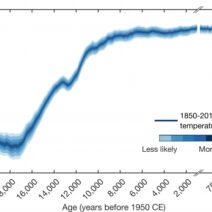In the contemporary discourse surrounding climate change, the narrative often oscillates between unmitigated optimism and stark realism. Innovations in technology serve as a dual-edged sword, offering both promise and peril. As inventions proliferate and evolve, their potential repercussions on global warming warrant meticulous examination. The question looms large: how could these inventions affect global warming? To elucidate this matter, we must explore both the benefits and detriments of technological advancements.
At the outset, it is crucial to recognize the remarkable advancements in renewable energy technologies. Solar panels and wind turbines exemplify how innovation can pivot us away from fossil fuels, traditionally viewed as principal contributors to greenhouse gas emissions. The deployment of renewable energy harnesses the natural forces of the sun and wind, significantly curtailing reliance on hydrocarbons. Transitioning to these sustainable alternatives not only diminishes the carbon footprint but also enhances energy security, making nations less vulnerable to geopolitical tensions surrounding oil and gas.
Moreover, advancements in battery storage technology are instrumental in this renewable revolution. Storing energy generated during peak production allows for a more consistent power supply, overcoming the intermittency associated with solar and wind energy. As battery technology improves, electric vehicles (EVs) become increasingly viable, further mitigating emissions from traditional combustion-engine cars. The electrification of transport signifies a pivotal shift, as EVs inherently possess a lower carbon footprint when powered by clean energy sources.
However, while the environmental merits of renewable energy are compelling, the associated manufacturing processes reveal a contrasting narrative. The production of solar panels and wind turbines necessitates substantial raw material extraction, often leading to ecological degradation and heightened carbon emissions. Mining operations disturb vast landscapes, threatening biodiversity and contributing to habitat loss. Additionally, the issuance of toxic byproducts from the manufacturing process poses risks to both human health and environmental integrity. Thus, the promise of clean energy does not come without its complexities.
Another compelling arena of technological innovation lies within carbon capture and storage (CCS) systems. These inventions are designed to capture up to 90% of the carbon dioxide emissions produced from fossil fuel use, subsequently storing it underground or repurposing it for other industrial applications. The potential of CCS to neutralize the impact of existing energy generation facilities presents a glittering solution amid mounting climate challenges. Moreover, if implemented at a global scale, it could allow developing nations to transition more gradually towards sustainable practices without sacrificing economic growth.
However, CCS is not without its discontents. Critics argue that promoting this technology could engender complacency regarding the urgent need for systemic change in energy consumption patterns. Rather than redefining reliance on fossil fuels, CCS could inadvertently prolong lifetimes of carbon-intensive systems. This represents a classic case of technological fixation, wherein solutions are sought in innovation while deferring requisite behavioral transformations. As society attempts to balance technological progress with sustainable practices, a more holistic approach is essential.
Furthermore, the rise of smart technologies and the Internet of Things (IoT) offers profound implications for energy efficiency. Intelligent systems can optimize energy usage in homes and industries, promoting substantial resource conservation. Automated management of heating, cooling, and lighting can yield significant energy savings that ultimately reduce greenhouse gas emissions. Integrating AI algorithms for predictive maintenance can further enhance operational efficiency across various sectors, thereby minimizing waste. In this instance, technology champions the cause of sustainability.
Yet, one must remain vigilant in addressing the environmental impacts of such smart devices. The resources required for their production—rare earth metals, significant energy input during manufacturing, and the consequential e-waste—pose environmental quandaries that cannot be ignored. Moreover, the ubiquity of these devices invites scrutiny regarding the expansive data centers necessary to power them. If their energy requirements are met through fossil-fueled sources, the net contribution could be detrimental.
In the agricultural sector, technological strides such as precision farming and genetically modified organisms (GMOs) promise to bolster crop yields while minimizing the environmental toll. Precision farming utilizes data-driven approaches to optimize resource use, decreasing the excess application of pesticides and fertilizers. This not only lessens soil and water pollution but also requires less energy overall, standing in stark contrast to conventional farming practices. GMOs, when deployed judiciously, could contribute to climate resilience by developing crops that withstand extreme weather events—temperature fluctuations, droughts, and floods.
Conversely, the use of GMOs engenders contentious debates around biodiversity and ecological balance. The introduction of genetically engineered organisms can disrupt local ecosystems and outcompete native species, potentially leading to unforeseen collateral damage. Furthermore, reliance on genetically modified crops raises ethical concerns regarding food sovereignty and monoculture practices, as corporate monopolization of seeds could undermine agricultural diversity.
Ultimately, the conundrum of technological innovation in relation to climate change manifests itself as a tightrope walk between aspirational goals and practical realities. Innovators and policymakers must work collaboratively to establish frameworks that prioritize environmental integrity while fostering technological advancements. The design and implementation of green technologies should be pursued with care, ensuring that sustainability remains paramount in the innovation agenda.
In conclusion, technology, as it stands today, indeed serves as a double-edged sword in the battle against global warming. While the prospects of renewables, CCS, smart technologies, and precision farming herald the potential for transformative change, they also underscore the imperative to remain vigilant against the pitfalls of environmental exploitation. The path forward necessitates a nuanced understanding of how these inventions interplay with natural systems, cultivating a balance that champions environmental stewardship alongside human ingenuity. In doing so, society can embark on an equitable and sustainable journey towards mitigating the pressing impacts of climate change.







